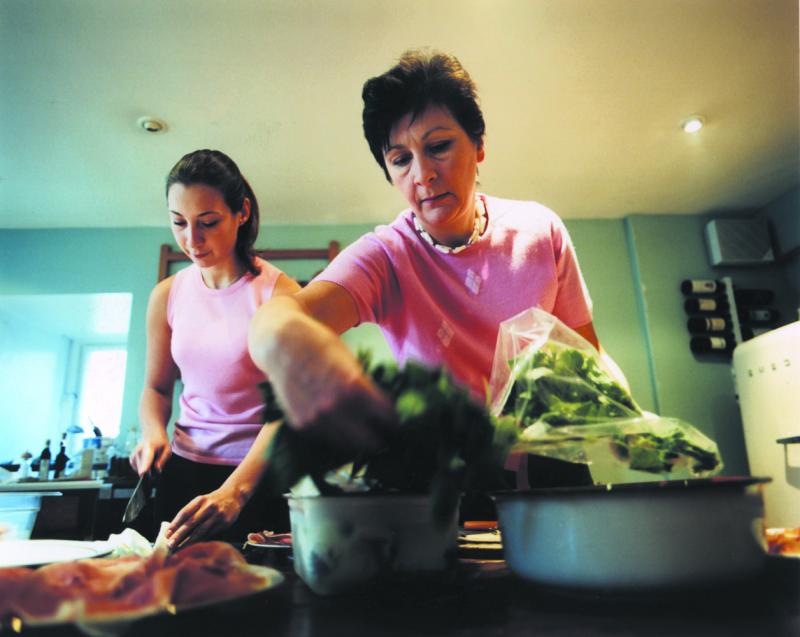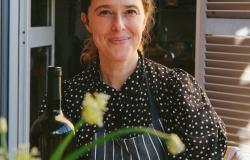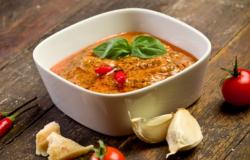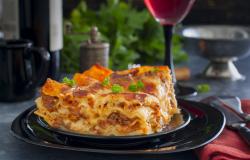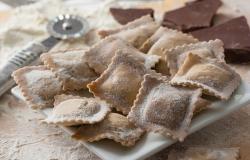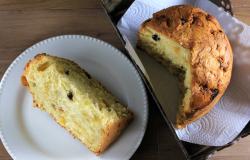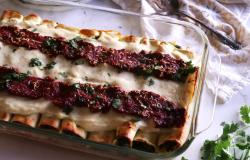Italian food writer Mary Contini describes some of her favourite recipes for the festive season.
Of all the places in the whole world, I would choose to be in Naples for Christmas. The bustle, excitement and spontaneity of the culture - everything about it guarantees a good time. Get there by the 16th of December to join the throngs and processions to celebrate the miraculous Liquefazione del Sangue di San Gennaro. Book one of the 185 red velvet and gold boxes arranged in six tiers and sit in the splendour of the Teatro San Carlo, the Neapolitan audience competing with the tenor for your attention. Choose hand-made figurines of the Nativity in the hundred or so hole-in-the-wall workshops of the Spacca Napoli and then soak up the intellectual artistic society in the Caffè Gambrinus sipping espresso and eating sfogliatelle. And find a Neapolitan family to eat with to enjoy the traditional feasting that is Natale a Napoli.
Salt Cod Baccalà
Traditionally eaten on La Vigilia di Natale – Christmas Eve – a day of fasting and abstinence.
Ingredients:
(serves four people)
*300g baccalà (salt cod)
*3 tbsps extra virgin olive oil
*1 medium onion, peeled and finely chopped
*1 piece peperoncino (dried chilli)
*4-5 tinned plum tomatoes
*8 pitted prunes (semi-dried ones are juicier and don’t have to be soaked)
*some flat-leaf parsley
The baccalà has to be soaked in several changes of cold water over two days before cooking so make sure you start this in time. Once this is done, rinse the cod and check it with your fingers, removing any bones.
Leave the skin intact to stop the cod disintegrating as it cooks. Cut into five or six pieces.

Heat the extra virgin olive oil in a saucepan and gently sauté the onion and chilli slowly until the onion is soft and transparent. Add the tomatoes, squash them down, and gently cook for about 20 minutes.
Lay the cod pieces on top of the tomato sauce, add the prunes and, with the saucepan lid on, steam the fish through - it takes barely 15 minutes. Taste at the end of cooking. It shouldn’t need any salt, but add some chopped flat-leaf parsley.
Porchetta con mostarda di Frutta/Roast Pork with Fruit ‘mostarda’
Ask the butcher to score the pork for you, tracing deep lines through the rind and fat. Prepare the pork on Christmas Eve.
Ingredients:
(serves four people)
*2kg rolled and boned loin of organic pork, with the rind still on
*1 tbsp extra-virgin olive oil
*Lemon juice
*Maldon sea salt
For the fresh sage pesto:
*2-3 cloves fresh garlic, peeled
*2 tbsps Maldon sea salt
*2 tbsps extra-virgin olive oil
*5 large handfuls fresh sage (don’t use dried sage) 1 tsp black peppercorns
Make the pesto in a pestle and mortar or in a food processor. Cream the garlic with the sea salt. Add the other ingredients and crush everything together to make a rough paste crushing the peppercorns roughly.
Open out the pork and rub the pesto all over the inside. Roll up the pork and, using butcher’s string, tie the roll together. (Start at one end, tying the string in loops, spaced out about two finger’s width apart. Use a second piece to tie a circle lengthwise across the loops, just like tying a parcel). Rub the outside of the pork with some extra virgin olive oil and some more salt. This helps to crisp the crackling. Leave it well covered with foil to marinade in the fridge overnight.

Remove the pork from the fridge half an hour before roasting it. Pre-heat a very hot oven: 230C/450F/Gas 8. Roast the pork for 20 minutes to start to crisp up the crackling.
Reduce the heat to fairly hot: 190C/375F/Gas 5 and roast for25 minutes per 500g.
Baste the pork with a little Lemon juice while it is cooking and test it 15 minutes before the allotted time. Push a skewer into the middle of the pork, away from the crackling for ease. The juices must run clear. If they are, remove the pork and leave it covered in a warm place before serving. If the juices are pink roast it for a further 15 minutes but do not overcook it or it will be dry.
Serve the pork with 2 or 3 pieces of Mostarda di Frutta to give a sweet and sour accompaniment to the flavours. Serve with crispy roast potatoes and some bitter scarola.
Scarola
A throwback from the Jewish tradition of eating bitter greens at Passover.
Ingredients:
(serves four people)
*500g bitter greens, curly endive or friarille, Neapolitan Winter greens.
*4-5 tbsps extra-virgin olive oil
*2-3 cloves garlic, peeled and finely chopped peperoncino (dried chilli) crumbled
*2 tbsps pine kernels, toasted in a medium oven for 5 minutes 1 tbsp raisins
Wash and trim the greens in plenty of changes of cold water to get rid of any grit. Trim away damaged leaves and keep the middle fine yellow leaves aside. Cut the leaves and cook them in boiling salted water for 10 minutes or so. Drain and squeeze out any excess water. If using spinach you won’t need to boil the leaves first.

Warm the olive oil in a large frying pan. Add the garlic and chilli (4-5 broken pieces to taste) and warm them through to start to flavour the oil. Add the toasted pine kernels and coat them in the oil. Add the drained greens, turn them in the flavoured oil and add a splash of water. Put a lid on, lower the heat and let the greens soften down for 10 minutes or so. Add the raisins at the end, just to heat them through.
Salt to taste.
Crustole
Christmas also means a celebration of traditional sweetmeats, Panforte di Siena, Panettone, Torrone and Almond Ricciarelli. In my family, we always make crustole, light, crisp pastries flavoured with Strega liqueur and icing sugar.
Ingredients:
(serves four people)
*1 large free-range egg
*1 tbsp unrefined caster sugar
*1 dsp light olive oil
*1 dsp Strega Liqueur or Marsala
*3-4 large tbsps plain flour, sieved
*Light olive oil or sunflower oil to fry More caster sugar or runny honey to serve
Beat the egg and sugar together, then beat in the olive oil and Strega. Gradually add enough flour to make a mixture just dry enough to handle. Using a small amount of the pastry at a time, roll it out in a pasta machine or by hand in a fine strip as thin as you dare. It tends to stick, so dust it with plenty of flour as you go.
Using a pastry cutter, cut long ribbons 15cm long, 2-3cm wide. Fold each strip into a figure of eight, pressing the ends together to make a bow.

Fry immediately to prevent it collapsing. Heat the oil in a wide frying pan – the pastry will double in size as it cooks. Test the oil is hot enough by adding a little pastry which should sizzle and move, but not burn. Cook two to three at a time, turning them as soon as they start to become golden. They take only 1-2 minutes to cook. Don’t let them burn or darken in the oil.
Drain, blot on kitchen paper and pile onto a large flat dish. As they cool, sprinkle with caster sugar or drizzle with runny honey. Magically, they stay crisp for two to three days.
Yum Yum Pudding
This pudding is lighter than traditional Christmas pudding and needs a little as a day or two to mature - great if, like me, you’re not organised.
Before beginning make sure you have the right-sized pudding bowls, greaseproof paper and string to cover them with. This is enough to make two 600ml puddings, or one 1.2 litre pudding. You can use plastic pudding bowls for convenience, but I prefer the traditional ceramic ones. Make sure you have a pot with a tight-fitting lid that will hold the bowl comfortably with water a third of the way up.
Ingredients:
(serves four people)
*500ml cold water 250g caster sugar 125g unsalted butter 2 tbsps treacle
*2 tsps ground cinnamon
*1 tsp ground cloves
*a good grating of nutmeg
*750g dried seedless muscatel raisins (or mixed dried fruit, but no currants) 450g plain flour
*3 tsps bicarbonate of soda
*a pinch of fine sea salt
*6 silver threepenny bits (or six 5p coins) granulated sugar and some brandy to set it alight
Put the water, sugar, butter, treacle, spices and fruit into a saucepan, stir and slowly bring to the boil. Switch the heat off and allow the mixture to cool. Stir it now and then as it cools. The fruit starts to swell as it absorbs the water and melted butter. This stage is very important. If the fruit does not absorb most of the liquid, the pudding may not steam well.
When the fruit is barely lukewarm, sift the flour, bicarbonate of soda and salt into the mixture, and stir in. Add the silver coins, each wrapped in a little foil. Grease the pudding bowls well and put a circle of foil on the bottom so that the pudding will tip out nicely. Don’t risk the pot boiling dry as you steam the puddings. Set a timer and check the water level every half hour or so. If using a plastic bowl, sit it in on an upturned saucer so that even if it does boil dry, the pudding will just stop steaming.

Divide the mixture between the bowls you are using, and cover each bowl with a double sheet of greaseproof paper. Put a fold in the paper to give a bit of slack as the pudding rises in the bowl. Get help to tie a piece of string round to secure the paper round the rim and tie it over the top to make a handle. Use this to lower the pudding in and out of the boiling water. Steam the smaller puddings for 2 1/2 - 3 hours, 3-4 if it’s one big one. Let them cool completely and check with a skewer that the mixture is set in the middle, otherwise steam them longer.
Yum Yum pudding stays in good condition for two to three months. I’m usually not organised, and make them just a few days before Christmas. They’re always lovely. When you re-heat them you’ll need to steam them for 2 hours at least.
Complete the ritual by setting the pudding alight with brandy. Tip the pudding out of the bowl onto a warm serving plate and sprinkle a good tablespoon of granulated sugar over the top. Warm 5-6 tablespoons brandy (at least!) in a small saucepan. Warm a ladle over a flame, spoon out the hot brandy and set it alight as you pour it over the pudding. Serve with home-made custard and cream. It is Christmas after all!
 Mary Contini is a director of the famous Italian delicatessen and prize-winning wine merchant, Valvona & Crolla
Mary Contini is a director of the famous Italian delicatessen and prize-winning wine merchant, Valvona & Crolla (see p81) and the author of Dear Francesca, A Cookbook with Love
.
